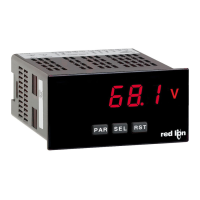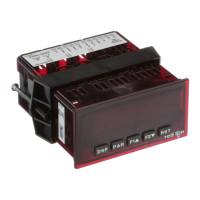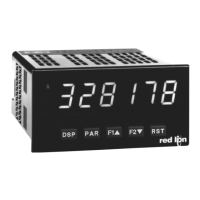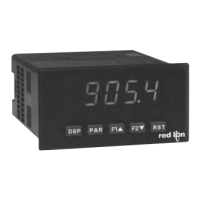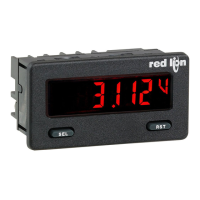35
within the data field. Negative values have a leading minus sign. The data field
is right justified with leading spaces.
The end of the response string is terminated with a carriage return <CR> and
<LF>. When block print is finished, an extra <SP><CR> <LF> is used to
provide separation between the blocks.
Abbreviated Transmission (Numeric data only)
Byte Description
1-12 12 byte data field, 10 bytes for number, one byte for sign, one byte for
decimal point
13 <CR> carriage return
14 <LF> line feed
15 <SP>* (Space)
16 <CR>* carriage return
17 <LF>* line feed
* These characters only appear in the last line of a block print.
Meter Response Examples:
1. Address = 17, full field response, Count A = 875
17 CTA 875 <CR><LF>
2. Address = 0, full field response, Setpoint 2 = -250.5
SP2 -250.5<CR><LF>
3. Address = 0, abbreviated response, Setpoint 2 = 250, last line of block print
250<CR><LF><SP><CR><LF>
Auto/Manual Mode Register (MMR) ID: U
This register sets the controlling mode for the outputs. In Auto Mode (0) the
meter controls the setpoint and analog output. In Manual Mode (1) the outputs
are defined by the registers SOR and AOR. When transferring from auto mode
to manual mode, the meter holds the last output value (until the register is
changed by a write). Each output may be independently changed to auto or
manual. In a write command string (VU), any character besides 0 or 1 in a field
will not change the corresponding output mode.
U abcde
e = Analog Output
d = SP4
c = SP3
b = SP2
a = SP1
Example: VU00011* places SP4 and Analog in manual.
Analog Output Register (AOR) ID: W
This register stores the present signal value of the analog output. The range
of values of this register is 0 to 4095, which corresponds to the analog output
range per the following chart:
Register
Value
Output Signal*
0-20 mA 4-20 mA 0-10 V
0 0.00 4.00 0.000
1 0.005 4.004 0.0025
2047 10.000 12.000 5.000
4094 19.995 19.996 9.9975
4095 20.000 20.000 10.000
*Due to the absolute accuracy rating and resolution of the output card, the
actual output signal may differ 0.15% FS from the table values. The output
signal corresponds to the range selected (0-20 mA, 4-20 mA or 0-10 V).
Writing to this register (VW) while the analog output is in the Manual Mode
causes the output signal level to update immediately to the value sent. While in
the Automatic Mode, this register may be written to, but it has no effect until the
analog output is placed in the manual mode. When in the Automatic Mode, the
meter controls the analog output signal level. Reading from this register (TW)
will show the present value of the analog output signal.
Example: VW2047 will result in an output of 10.000 mA, 12.000 mA or
5.000V depending on the range selected.
Setpoint Output Register (SOR) ID: X
This register stores the states of the setpoint outputs. Reading from this
register (TX) will show the present state of all the setpoint outputs. A “0” in the
setpoint location means the output is off and a “1” means the output is on.
X abcd
d = SP4
c = SP3
b = SP2
a = SP1
In Automatic Mode, the meter controls the setpoint output state. In Manual
Mode, writing to this register (VX) will change the output state. Sending any
character besides 0 or 1 in a field or if the corresponding output was not first in
manual mode, the corresponding output value will not change. (It is not
necessary to send least significant 0s.)
Example: VX10* will result in output 1 on and output 2 off.
COUNTER C SERIAL SLAVE DISPLAY
Counter C may be programmed for SLAUE to act as a serial slave display. In
this mode, the carriage return <CR> is added as a valid command terminator
character for all serial command strings. The <CR> as a terminator may be very
useful for standard serial commands, even if Counter C is never displayed or
sent a slave message. The <*> and <$> are also recognized as valid terminators
for the serial slave.
The Counter C slave display is right aligned, and has the capacity of
displaying six characters on Line 1 or nine characters on Line 2. When less than
the full display of characters is received, blank spaces are placed in front of the
characters. If more than the full display of characters is received, only the last
six (or nine) characters are displayed. The meter has an internal 300 character
buffer for the slave display. If more than 300 characters are received, the
additional characters are discarded until a <CR> is received. At that point, the
last six (or nine) characters in the buffer are displayed.
Counter C processes Numeric and Literal slave transmissions as follows.
Numeric Transmissions
When a string that does not begin with #, T, V, P or R is received, the meter
processes it as a Numeric transmission. In this case, only numbers and a minus
sign can be displayed. All other characters in the string are discarded. If a minus
sign appears anywhere in the string the resulting number will be negative. If a
decimal point is desired, it is programmed in Counter C setup and is ignored in
the serial string. If no numerical characters are received, then the numeric value
will be zero.
The numeric display can be used for setpoint (boundary action only) and
analog output functions. The numeric value is retained in Counter C memory
until another Numeric transmission is received. If a numeric values is not to be
saved to non-volatile memory, send the value as a literal transmission.
Note: Numeric transmissions sent to meter addresses 1 through 9 must have a
leading zero character sent with the address (i.e. N01 through N09).
Literal Transmissions
When a string that begins with # is received, the meter processes it as a Literal
transmission. In this case, only numeric and alphabetic characters or a minus
sign (dash) will be processed. Any other non-alphanumeric character will be
discarded. Non-displayable alphabetic characters (M, W and X) will be replaced
with a space. A Literal display overrides any Units Mnemonics characters, when
shown on Line 2.
A Literal display will replace a Numeric value in the Counter C display.
However, it will not remove a previous Numeric value from Counter C memory
or prevent the Counter C assigned outputs from functioning with the previous
Numeric value.
Displayable Alphabetic Characters:
ASCII
AbCdEFGHI JKLNOPqrSt UVYZ
DISPLAY
AbC dE FG H IJk LN O P qrS tU U Y Z
(Both uppercase and lowercase ASCII characters are accepted.)
Downloading Data from a G3 to a PAX2D
Communications:
Port: RS232 Comms Raw Serial Port
Port Driver: <system> Raw Serial Port
Programming:
PortPrint(2, “N01” + IntToText(Var1, 10, 6) + “\r”);
This program is called from the Global On Tick. It sends “N01” (the meter
address), followed by the ASCII equivalent of Var1, then a carriage return.
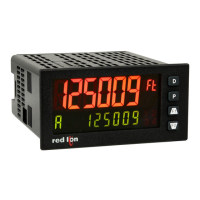
